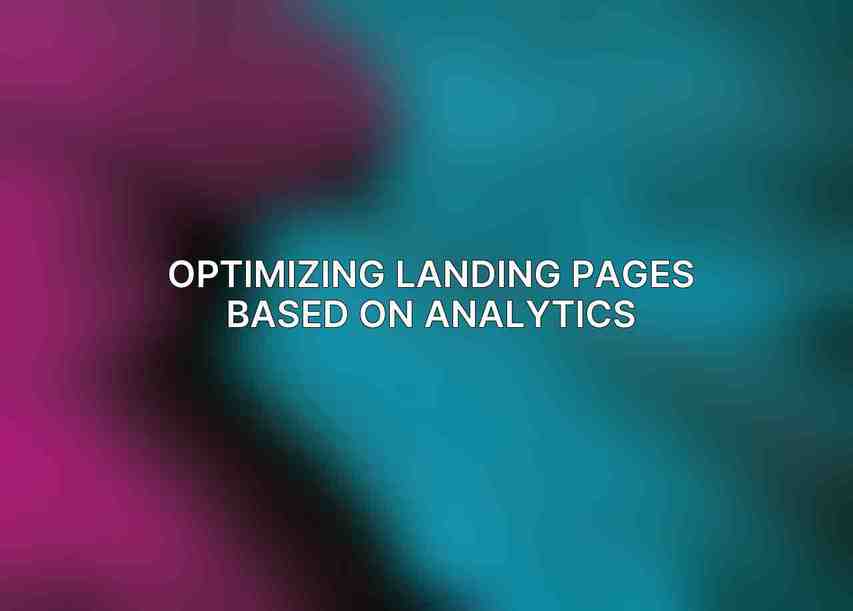Landing pages play a crucial role in digital marketing campaigns, serving as the entry point for potential customers and the gateway to conversions. These standalone web pages are designed with specific objectives in mind, whether it’s capturing leads, promoting a product, or driving event registrations. Understanding the performance of these landing pages is vital for marketers to refine their strategies and maximize results. This is where landing page analytics come into play, providing valuable insights into visitor behavior, engagement, and conversion rates.
Key Metrics for Landing Page Analysis
When it comes to analyzing the effectiveness of landing pages, several key metrics help paint a comprehensive picture of performance:
A. Conversion Rate
The conversion rate is a fundamental metric that indicates the percentage of visitors who complete a desired action on a landing page. Whether it’s making a purchase, filling out a form, or signing up for a newsletter, tracking conversions is essential for assessing the success of a page. Industry benchmarks can provide context on what constitutes a good conversion rate and where improvements may be needed.
B. Bounce Rate
The bounce rate reflects the percentage of visitors who navigate away from a landing page without interacting further. High bounce rates signal potential issues with the page’s relevance, user experience, or targeting. Factors such as page load speed, content quality, and navigation can contribute to increased bounce rates.
C. Time on Page
The time on page metric measures how long visitors spend engaging with the content on a landing page. It provides insights into user behavior and interest levels. By analyzing time on page metrics, marketers can determine whether visitors are finding the content valuable and engaging enough to stay longer.
D. Goal Completions
Goal completions refer to specific actions or events that demonstrate a successful outcome on a landing page. This could include newsletter sign-ups, product purchases, or software downloads. Defining clear goals and tracking their completions is essential for measuring the impact and effectiveness of a landing page.
Tools for Landing Page Analytics
Utilizing the right tools is essential for effectively monitoring and optimizing landing page performance. Some of the key tools for landing page analytics include:
A. Google Analytics
Google Analytics stands out as a powerful tool for tracking website and landing page performance. It offers a range of features and capabilities, including the latest version, Google Analytics 4, which provides enhanced insights and reporting options. Additionally, the platform offers Enhanced Ecommerce functionality for in-depth analysis of product performance and customer behavior.
B. Heatmaps
Heatmap tools like Crazy Egg and Hotjar provide visual representations of user interactions on landing pages. Click heatmaps reveal where users are clicking the most, while scroll heatmaps indicate how far visitors are scrolling down the page. These insights help identify areas of high engagement and potential optimization opportunities.
C. Form Analytics
Form analytics tools help marketers analyze user interactions with forms on landing pages. By tracking form submissions, identifying drop-off points, and optimizing form fields, marketers can reduce friction and improve conversion rates. Tools like Formisimo offer actionable insights into form performance.
D. A/B Testing
A/B testing, also known as split testing, is a method for comparing two versions of a landing page to determine which performs better in terms of conversion rates. By testing variations of elements such as headlines, CTAs, or images, marketers can make data-driven decisions to optimize landing page effectiveness and drive better results. Check this blog on Essential Elements for High-Converting Landing Pages Design
Analyzing Landing Page Data

To make informed decisions and drive improvements in landing page performance, marketers need to analyze and interpret the data collected through analytics tools:
A. Using Google Analytics Dashboards and Reports
Google Analytics offers customizable dashboards and reports that allow marketers to monitor key metrics like conversion rates, bounce rates, and page views. By leveraging these insights, marketers can track performance trends and make informed decisions to optimize landing pages.
B. Identifying Trends and Patterns
Analyzing landing page data over time helps identify trends and patterns in visitor behavior. By observing changes in metrics and performance, marketers can identify areas for improvement and capitalize on successful strategies to enhance overall performance.
C. Segmenting Visitors
Segmenting visitors based on demographics, behavior, or referral sources enables marketers to analyze specific user groups and tailor landing page experiences accordingly. By understanding the needs and preferences of different segments, marketers can deliver more personalized and targeted content.
D. Using Heatmaps for Visualization
Heatmaps provide visual representations of user interactions, highlighting areas of interest and engagement on landing pages. By leveraging heatmaps, marketers can visualize visitor behavior, identify potential usability issues, and optimize page elements for better user experience and conversion rates.
E. Testing Different Elements
Conducting A/B tests on landing page elements such as headlines, CTAs, images, and layouts helps determine the most effective combinations for driving conversions. By experimenting with variations and measuring results, marketers can fine-tune their landing pages for optimal performance and engagement.
Optimizing Landing Pages Based on Analytics

Armed with valuable insights from analytics tools, marketers can implement strategies to optimize landing pages for improved performance:
A. Improving Conversion Rate
By fine-tuning content, addressing friction points, and enhancing user experience, marketers can boost conversion rates on landing pages. Testing different elements and iterations based on analytics data can lead to significant improvements in conversion metrics.
B. Decreasing Bounce Rate
To reduce bounce rates, marketers need to focus on improving page load speed, ensuring content relevance, and providing clear navigation paths. By optimizing landing pages to engage and retain visitors, marketers can effectively decrease bounce rates and improve overall performance.
C. Increasing Time on Page
Engaging visitors with compelling content, interactive elements, and relevant visuals can increase the time users spend on landing pages. By analyzing time on page metrics and optimizing content for greater engagement, marketers can enhance user experience and encourage deeper interactions.
D. Achieving Goal Completions
Optimizing call-to-actions, providing clear instructions, and minimizing distractions are key strategies for driving goal completions on landing pages. By refining CTAs based on analytics insights and eliminating potential barriers to conversion, marketers can increase the likelihood of users completing desired actions.
landing page analytics play a crucial role in guiding data-driven optimization strategies for digital marketing campaigns. By leveraging key metrics, tools, and insights, marketers can refine their landing pages to enhance conversion rates, reduce bounce rates, increase engagement, and drive goal completions. Continuous analysis, experimentation, and optimization are essential to improving landing page efficiency and achieving success in digital marketing endeavors. Through a holistic approach to landing page analytics, marketers can unlock valuable insights and opportunities for ongoing improvement and growth. Read more about this on Top SEO Best Practices for Your Landing Page Design
Frequently Asked Questions
What is a landing page?
A landing page is a standalone web page specifically created for a marketing or advertising campaign. It is where a visitor ‘lands’ after clicking on a link in an email, an ad, or any other online location.
Why is analytics important for landing pages?
Analytics provide valuable insights into the performance of a landing page by tracking user behavior, conversions, and other key metrics. This data helps in identifying strengths and weaknesses, enabling optimization for better results.
How can analytics help improve landing page efficiency?
Analytics can reveal which elements of a landing page are effective and which need improvement. By analyzing data such as bounce rates, conversion rates, and click-through rates, adjustments can be made to optimize the page for better performance. Learn more about Latest Trends in Landing Page Design for Online Business Growth
Which analytics tools are recommended for monitoring landing page performance?
Some popular analytics tools for tracking landing page performance include Google Analytics, Kissmetrics, Crazy Egg, and Hotjar. These tools provide detailed data on visitor behavior and engagement, helping in optimizing landing pages for better efficiency.
What are some key metrics to monitor when analyzing landing page efficiency?
Key metrics to monitor include conversion rate, bounce rate, average time on page, click-through rate, return on investment (ROI), and overall user engagement. Tracking these metrics can help in understanding the effectiveness of a landing page and making necessary improvements.

